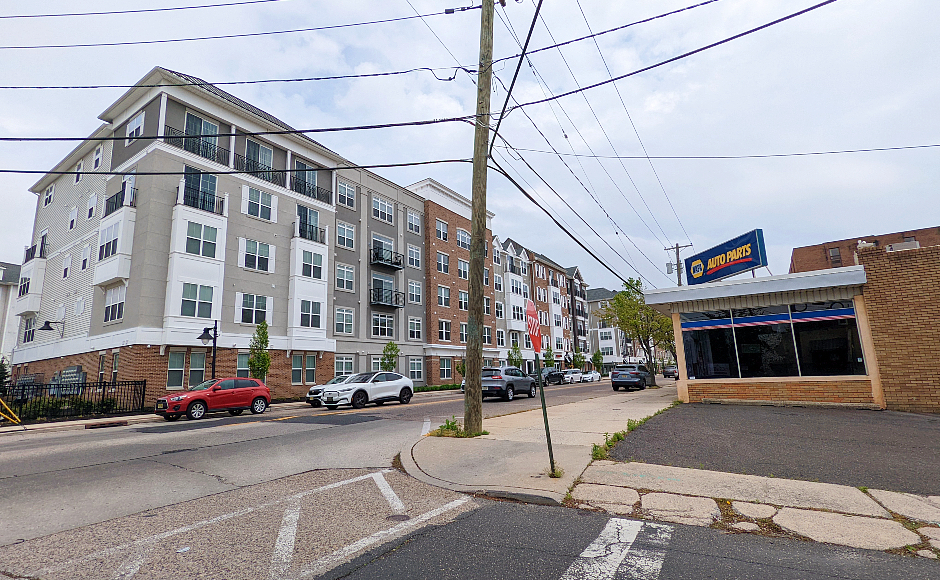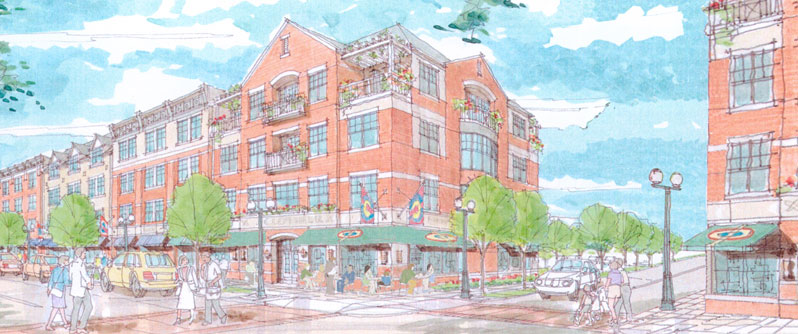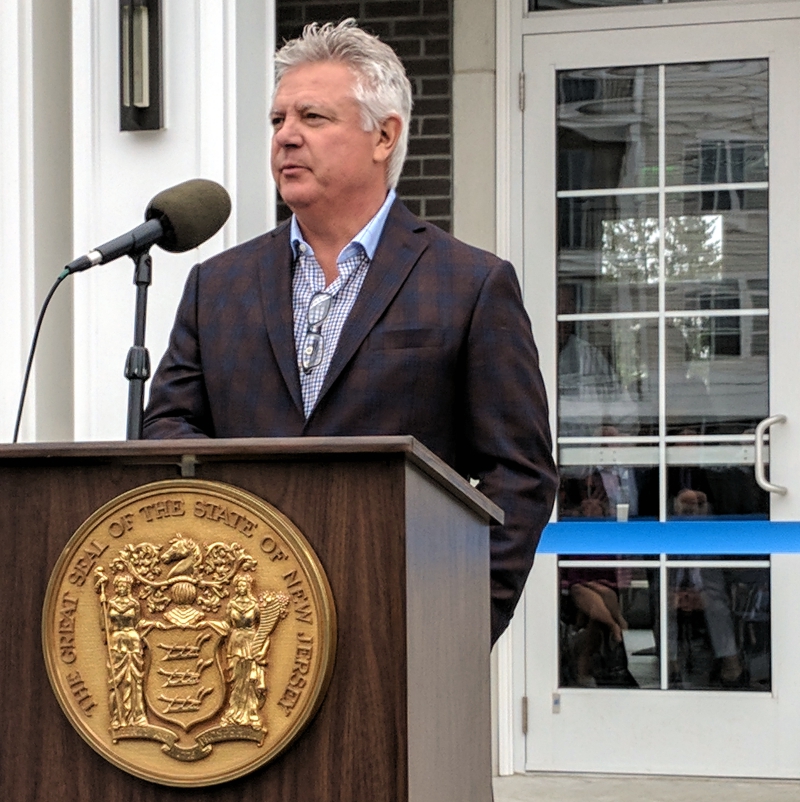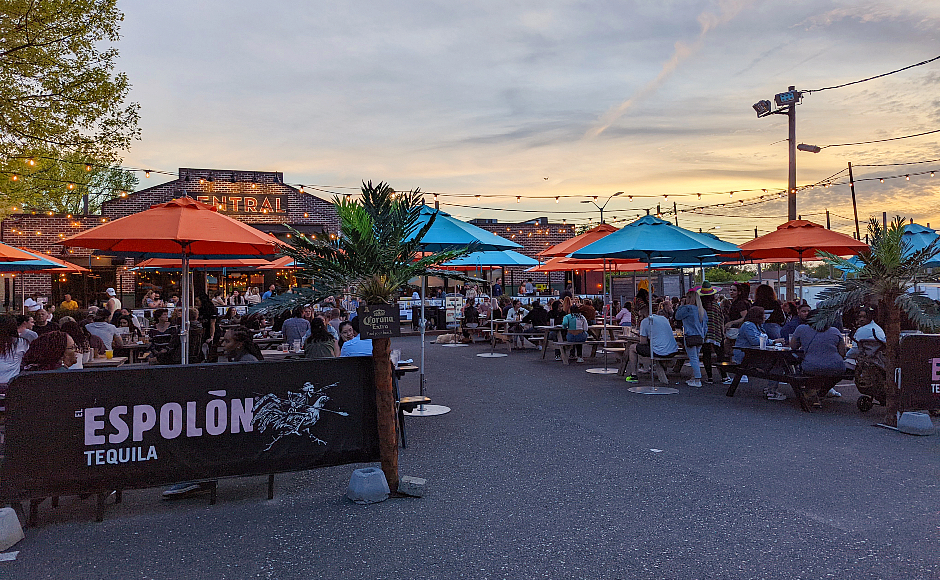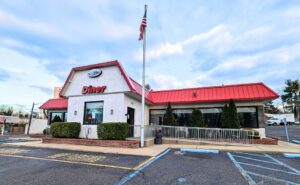Fieldstone Associates, the property group behind the Dy Dee Diaper Wash brownfield redevelopment, is suing Dave Welsh and the Haddon Township government to keep the project from proceeding.
By Matt Skoufalos | May 9, 2022
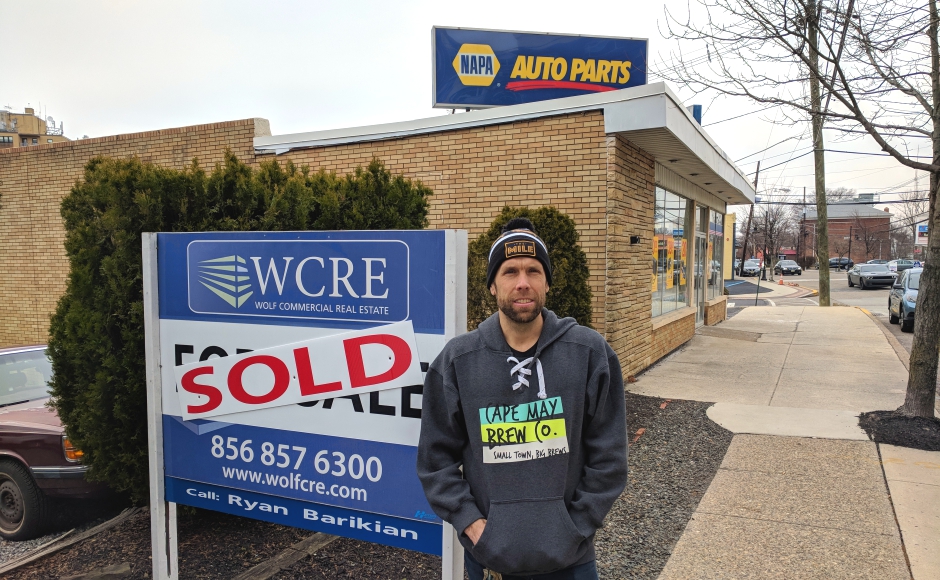
Dave Welsh stands outside the Napa Auto store in Haddon Township that he plans to convert into Reunion Hall. Credit: Matt Skoufalos.
For the past three years, Haddon Township native Dave Welsh has worked to bring his indoor/outdoor beer garden and food hall concept, Reunion Hall, to Haddon Avenue.
And for the past two years, despite the project having cleared the Haddon Township Planning and Zoning Board, Welsh has been battling to get it off the ground.
After multiple delays throughout 2020, some attributable to the novel coronavirus (COVID-19) pandemic, and others related to tabled discussions at land use hearings, the project was approved by the body in November 2020.
Within weeks of that approval being issued, Welsh and the township itself were served with a lawsuit from Fieldstone Associates of Bridgewater, the company behind the Haddon Towne Center project, which faces the proposed location of Reunion Hall in the 200 block of Haddon Avenue.
In its objections to the project, Fieldstone alleges:
- that the board acted arbitrarily in granting a parking variance to Reunion Hall;
- that the adjoining property from which Welsh leased 35 additional spaces to cover the project parking obligation failed to seek approval for its lot being used in this fashion;
- that because Welsh incorporated a second entity, known as DJW Properties, for the purposes of leasing these spaces to Reunion Hall, it shouldn’t be able to apply them to Reunion Hall;
- that Reunion Hall requires 59 parking spaces under the township parking statute, and that the project shouldn’t be allowed to use on-street parking to achieve that count.
Parking in downtown Haddon Township has been a subject of discussion for years, particularly as businesses along its densely developed Haddon Avenue economic corridor often do not own private parking lots at which to accommodate their customers. In 2017, the township addressed some of this by relaxing parking standards for businesses of 900 square-feet and fewer, and its 2019 master plan update recommended further addressing parking minimums in the downtown district altogether.
At the time, Haddon Township Commissioner Ryan Linhart said:
“The intention is for the township to reduce and potentially eliminate parking minimums for retail and food operating businesses in the business district in order to reduce the friction for new businesses to come in.”
“As it stands, all these requirements hinder new businesses coming into the area,” Linhart said. “The goal is to draw more foot traffic, and more businesses will do that.”
But so far, the only action the township has taken towards that goal has been to relax parking obligations for bars and restaurants slightly. According to the local parking ordinance, amended most recently in August 2021, “restaurants, nightclubs, taverns or similar use” require “one space per five seats for patrons whether at a bar, counter or tables, plus one space for every two employees at peak hours.” That’s down from one space per three customer seats in an earlier iteration of the rule.
As approved, Reunion Hall has a 151-seat capacity, which would obligate the property to account for 30 parking spaces, plus another seven for its 14 employees, for a total of 37 spaces. After securing a five-year lease for the 35-space parking lot behind the property, Reunion Hall is still two parking spots short of that standard.
Welsh proposed that the difference could be made up in street parking along Haddon Avenue, and the Haddon Township Planning and Zoning Board granted the project relief from the parking standard in November 2020, when it approved the plan.
Fieldstone, which retained counsel and multiple subject experts in its objections to the project throughout the planning and zoning process, claims the street parking in the area has already been allocated for use by its commercial tenants. The developer believes that ceding any space to Reunion Hall undercuts its share of street parking.
“Their objection, from what I understand, is that they need that little bit of parking on Haddon Avenue to take care of their tenants,” Welsh said. “But when they designed Haddon Towne Center, they were supposed to build a parking garage.
“Street parking is street parking,” he said. “It can be counted for anybody. No one owns it.”
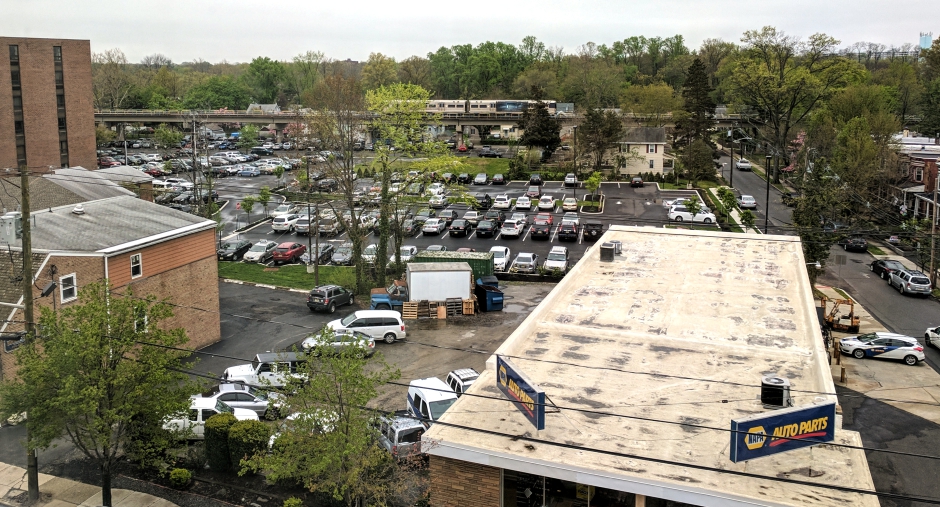
View of the PATCO Speedline from the 1000 building of the Haddon Towne Center across the street. Credit: Matt Skoufalos.
Welsh said that despite repeated conversations with Fieldstone, the two sides couldn’t come to terms on the issue.
“We tried to settle this offline, and no matter what we offered, there was no compromise,” he said.
“We offered to reduce the seating more; we looked for other parking elsewhere.
“But the parking demand they want is unrealistic, and goes above and beyond the ordinance,” he said.
“Nobody knows what the endgame is,” Welsh said. “I don’t know why they think Reunion Hall is going to negatively affect them. Right now, you’ve got an abandoned NAPA Auto building across the street as opposed to having a well-done, unique, modern foodery.”
The case heads to Camden County Superior Court in June. Welsh is named as a defendant, and so is the Haddon Township government, for its decision to grant a parking variance in approving the project.
Welsh contends that Fieldstone has been attacking Reunion Hall alone, even as other restaurant projects that required parking relief from the board have come and gone in the intervening months without comment from the developer, including Tacconelli’s Pizza, which will open across the street from the Reunion Hall site.
In the three years since he first pitched Reunion Hall, the legal delays have driven the cost of the project “through the roof,” Welsh said.
“The cost to build Reunion Hall has now doubled, plus the time it takes to get materials,” he said. “I’ve lost two years of revenue opportunity.”
Welsh’s chief argument against the parking obligation is that Reunion Hall is located in a downtown walking district, within a block of a public transit hub (the PATCO Speedline station), and will incentivize alternative commuters by virtue of onsite bike racks and rideshare services.
“We’re going to bring a city concept to a suburb of Philadelphia,” Welsh said. “You’re in a downtown that’s walkable. How many people are going to bike to this place, walk to this place, Uber to this place?
“What the town says is what I’m going to follow,” he said. “I’m not going to follow what another business across the street asks me to do.”
Past versus present
If there’s a parking problem at the Haddon Towne Center, it’s one that Fieldstone created for itself by expanding the original scope of the project, failing to anticipate in its revised design of the site plan, or minimized in its testimony during the approval process for the Towne Center project.
In its 2015 negotiations with the Haddon Township Planning and Zoning Board, Fieldstone appealed to the municipality to redesign the project without some of the features initially contemplated there, including concrete and steel parking garages, condominiums, and 25,000 square-feet of retail properties.
(It also accepted the award of a $6-million, 30-year PILOT agreement, held over from the original redevelopment deal and contingent upon real estate valuation.)
In addition, the Haddon Towne Center project, which was originally conceived without affordable housing units, would be required to include some as part of a settlement with Fair Share Housing.
To achieve this, Fieldstone asked the board for a height variance to raise the four-story project by one additional level, incorporating additional above-ground parking, and increasing the unit count from 227 to 252 to add in the affordable units.
The developer also halved the commercial square-footage that was to have occupied the site, from 25,000 to 12,500, filling in some of that space with first-floor residential units, which exist nowhere else in the Haddon Township central business district.
Fieldstone also got the board to downgrade its onsite parking obligation to three spaces per 1,000 square-feet of commercial area and 1.7 spaces per residential unit.
At the time, Fieldstone attorney Richard Goldman testified that the project, situated as it is across the street from the Westmont PATCO station, “is essentially a transit-oriented, mixed-use set of buildings.”
“One of the great benefits for that is a reduced need for cars and a capacity for shared parking,” Goldman said at the time. “During the day, when the retail needs the parking spaces, most of the residents are out.”
In those same conversations, Fieldstone principal Arthur Corsini also testified that the developer “has options” to alleviate parking concerns onsite.
His solutions?
Local public transit, the Zip Car car-share service, or the use of shared parking at adjacent nearby lots.
Corsini also opined that Fieldstone could lease-restrict parking spaces by the number of bedrooms per apartment (one space for one-bedroom units, and two for two- and three-bedroom units); whether that was ever achieved is unknown.
During that same testimony, Fieldstone parking and traffic expert David Shropshire told the board that 1.8 parking spaces per unit is a “reasonable if not high” threshold for the mixed-use project to achieve. Studies of comparable transit-oriented projects in northern New Jersey showed a parking demand more on the order of 1.3 spaces per unit, Shropshire said at the time.
(By comparison, the parking ratio for the Collings at the Lumberyard in nearby Collingswood is 0.8 spaces per unit.)
“I know that we’re looking at a 1.8 supply ratio for the units as it’s presently presented,” Shropshire said at the time. “I feel more than comfortable recommending to the board that a ratio of 1.5 is going to cover peak demand for this facility.”
By Shropshire’s math, that left Fieldstone needing 492 total recommended parking spaces, 449 of which were accounted for onsite, and 33 others of which would be provided by re-striping and re-aligning roadways along Glenwood, Center, Highland, and Haddon Avenues.
(Fieldstone’s lawsuit overstates this number as well, claiming that the developer worked “to create at great expense forty-three (43) additional on-street parking spaces adjacent to Towne Center.”)
Even with that accounting, Fieldstone still claimed in 2015 that 19 additional on-street parking spaces in the vicinity of the project could be used to satisfy its parking demand, according to its engineer Gary Civalier.
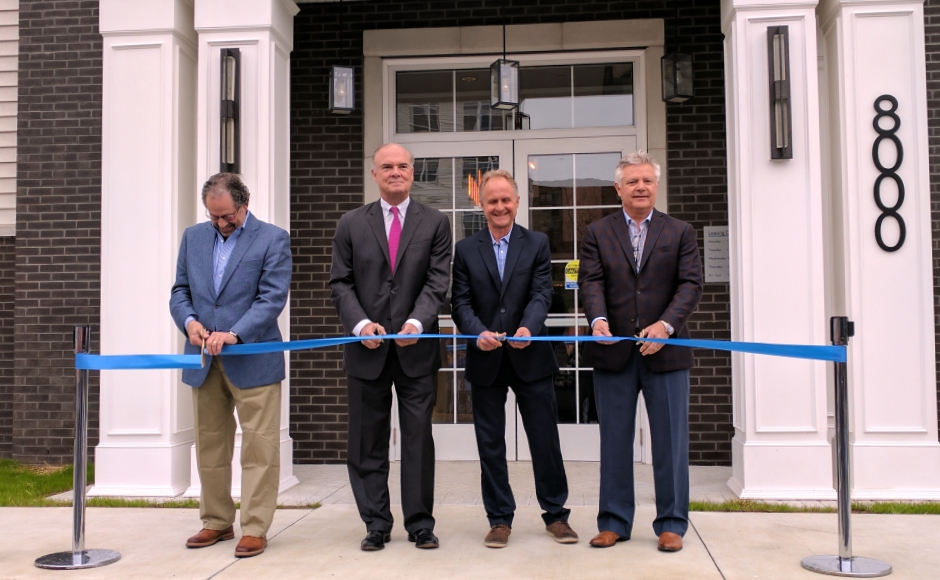
Ribbon-cutting at the Haddon Towne Center project. From left: Jorge Berkowitz, Bob Martin, Randy Teague, Art Corsini. Credit: Matt Skoufalos.
“When we designed this project, we hoped to get to 1.8 [spaces per unit], but that’s different from what this ordinance standard requires,” Goldman said at the time.
“I think what we are suggesting is a little bit of relief in the ordinance standard, even though we want to design to a higher standard, if possible.”
Despite appealing for—and receiving—the same parking relief to which it claims Welsh’s project is not entitled, Fieldstone principal Corsini claims in the suit that he has “turned down certain retail tenants because of the parking demand.”
That means that either Fieldstone created a project the commercial component of which was engineered to be unsustainable from a parking demand perspective, even with the additional relief awarded, or that parking demand isn’t the hardship that’s prevented it from leasing the space to other retail tenants. Complicating the matter was Fieldstone’s requests during the Haddon Towne Center negotiations that it be allowed to convert the first-floor commercial units into residential space should demand for them go unmet.
Welsh, who said he was in talks years ago to lease one of those retail spaces from Fieldstone, eventually abandoned those plans because the building design was unsuitable.
He was never told that parking would be an issue.
“We had a design laid out, but their infrastructure isn’t designed to be soundproof enough, and the plumbing done in a way to make it noise-prohibitive for tenants,” Welsh said. “The ceilings were too low to accommodate exhaust venting from the kitchen. We would have had limited hours.
“That lower level wasn’t designed to really host anything other than minimally sized retail,” he said; “things that close early and don’t make noise.”
A chilling effect
Chef Dominic Piperno, who is finalizing plans to redevelop a former furniture showroom into a 200-seat bar-restaurant on Haddon Avenue, worries that the Fieldstone lawsuit could have a chilling effect on other property owners in the township.
“We have a way larger building, twice the size of [Welsh’s], and we only have 25 [onsite] parking spots,” Piperno said.
“We’re afraid if we try to do a 200-seat bar-restaurant, what kind of parking are they going to require us to have Where am I going to find 40 spots if I need 65 spaces?” he said.
“You can’t produce parking lots,” Piperno said. “No restaurant around here offers private parking.”
Piperno, who is also the chef-owner at Hearthside BYOB in Collingswood, said almost none of the comparably sized establishments in downtown Westmont have enough onsite parking to achieve the current parking standard. In Collingswood, the 60-seat Hearthside offers two handicapped parking spots onsite; the remainder of its parking obligation is satisfied elsewhere.
“The borough understood that there’s plenty of street and neighborhood parking, and PATCO is a half-mile walk [from Hearthside],” Piperno said. “People don’t drive to bars with Uber and Lift. I feel like Collingswood gets that.”
Piperno further cited the transformation of parking lots into outdoor dining spaces at eateries like P.J. Whelihan’s, Central Taco, and The Pour House as examples that bar-goers are already finding ways to patronize the Haddon Township business district without placing undue hardship on property owners.
“It seems like the Haddon Towne Center, which should be on the forefront of more business coming to Haddon Township, are putting their knife into the backs of the town,” he said.
“They’re going to tell me what size business I can open? Limit my occupancy based on parking spots?” Piperno said.
“It seems very backwards to me that they would want to slow down or stop a potentially profitable type of business; one that could bring more people to Haddon Township.”
Piperno said he too was courted by Fieldstone to open an eatery in the Haddon Towne Center, but didn’t proceed because he determined, as Welsh had, that a professional hood system couldn’t be installed within its eight-foot ceilings. The decision by Fieldstone to target Welsh’s project smacks of “some kind of hidden agenda,” he said.
“What Dave’s trying to do is bring a really cool concept to the area,” Piperno said. “Independently owned businesses are something we should all be caring about. They employ local people.
“I don’t see [Fieldstone] going after PJ’s, because they’ll lose,” he said. “They’re picking and choosing who they want to fight, and they hope the small guy lays down.”

Andrew Svekla, Smart Growth Manager for the Delaware Valley Regional Planning Commission. Credit: Andrew Svekla.
‘Seems like a personal vendetta’
Andrew Svekla, Smart Growth Manager for the Delaware Valley Regional Planning Commission (DVRPC), the regional planning apparatus for the Philadelphia metro area, said that although it’s unusual for developers to sue one another over projects within the same community, issues about parking are intrinsically tied to issues around real estate development.
“The thinking on parking has evolved in recent years to try to understand that the way we manage parking can also help us think about how we can advance community goals related to social equity, sustainability, and community goals even beyond transportation,” Svekla said.
Building a dense, mixed-use real estate project across the street from a commuter rail like the PATCO Speedline encourages less vehicle use by tenants, who enjoy having walkable amenities in proximity to those housing developments, he said.
“From a general perspective, no one is coming to one of these town-center environments for the ease of parking,” Svekla said. “They’re coming for the experience reasons. Part of what makes them attractive is that there might be slower speeds and the ability to walk between buildings.”
Svekla said that Fieldstone itself must acknowledge the value of access to the PATCO Speedline in Haddon Township by virtue of its decision to build the Haddon Towne Center there. The commuter service is a boon to the viability of local commercial interests because it “has always been a lifestyle network based on its around-the-clock operations,” he said.
“By adding that transit catchment area, these businesses really do have a much more expansive area to draw from,” Svekla said.
From a planning perspective, “there’s no single right number of parking spaces for a given use,” Svekla said. Instead, he described parking capacity as a negotiation among stakeholders.
“We try to emphasize that the design of parking is really a value judgment that a neighborhood has to make for itself based around community goals,” he said. “[If] you’re thinking about parking in a district perspective, I expect to walk in a busy, vibrant downtown.
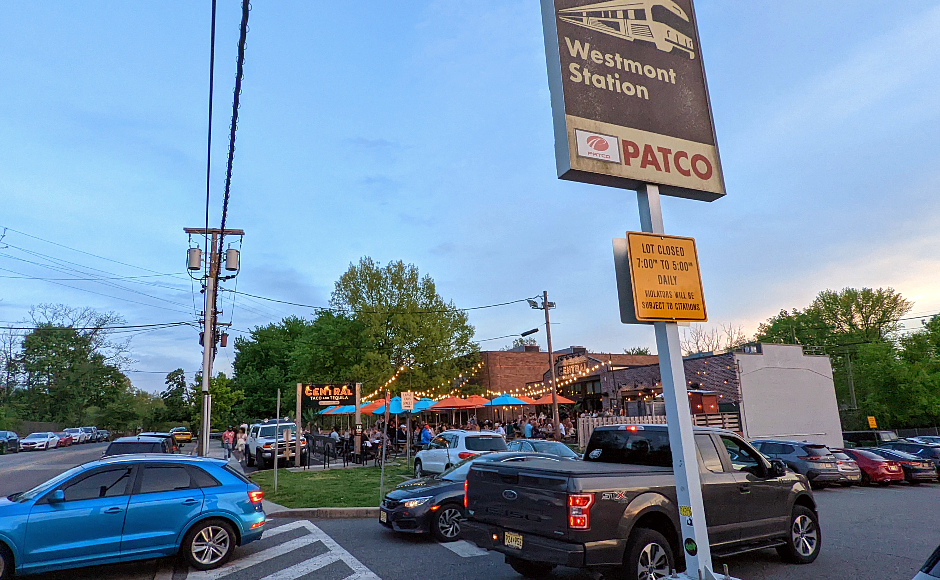
Overflow parking at the adjoining PATCO station supports Central Taco using its Westmont parking lot for additional outdoor seating. Credit: Matt Skoufalos.
“[Reunion Hall] seems like an amenity that would make living at the apartment complex more attractive,” he said.
Svekla also said that it’s unreasonable, although not unhead-of, for property owners to claim street parking as belonging to their property by virtue of its location.
In Fieldstone’s lawsuit, planner Creigh Rahenkamp claimed that because the on-street parking nearest to the Haddon Towne Center had been previously allocated for use by its tenants, it “would be a mistake” to count those towards satisfying the Reunion Hall parking obligation.
But Svekla said competition over street parking is rooted in assumptions that inaccurately commoditize a shared resource.
“There’s differences between what street parking is versus private automobile storage,” he said.
“Street parking, particularly in the downtown business district, is something that should be provided to folks and managed to turn over so folks can support private businesses,” Svekla said. “There’s no single number for having enough parking, and there’s no such set demand that’s fixed or unchangeable.”
Svekla also said that conversations about parking aren’t usually driven by developers in opposition to another nearby development project.
“Usually we’re trying to address resident concerns about parking; that there will be spillage into the neighborhoods,” he said. “This seems like a different sort of personal vendetta that I’m surprised about.”
Neither Fieldstone nor its attorneys responded to requests seeking comment for this story; likewise, officials from the Haddon Township government declined to speak on the subject, citing the pending litigation.
Stick with NJ Pen for updates.

